Brain Ultrastructure: Putting the Pieces Together
- PMID: 33681208
- PMCID: PMC7930431
- DOI: 10.3389/fcell.2021.629503
Brain Ultrastructure: Putting the Pieces Together
Abstract
Unraveling the fine structure of the brain is important to provide a better understanding of its normal and abnormal functioning. Application of high-resolution electron microscopic techniques gives us an unprecedented opportunity to discern details of the brain parenchyma at nanoscale resolution, although identifying different cell types and their unique features in two-dimensional, or three-dimensional images, remains a challenge even to experts in the field. This article provides insights into how to identify the different cell types in the central nervous system, based on nuclear and cytoplasmic features, amongst other unique characteristics. From the basic distinction between neurons and their supporting cells, the glia, to differences in their subcellular compartments, organelles and their interactions, ultrastructural analyses can provide unique insights into the changes in brain function during aging and disease conditions, such as stroke, neurodegeneration, infection and trauma. Brain parenchyma is composed of a dense mixture of neuronal and glial cell bodies, together with their intertwined processes. Intracellular components that vary between cells, and can become altered with aging or disease, relate to the cytoplasmic and nucleoplasmic density, nuclear heterochromatin pattern, mitochondria, endoplasmic reticulum and Golgi complex, lysosomes, neurosecretory vesicles, and cytoskeletal elements (actin, intermediate filaments, and microtubules). Applying immunolabeling techniques to visualize membrane-bound or intracellular proteins in neurons and glial cells gives an even better appreciation of the subtle differences unique to these cells across contexts of health and disease. Together, our observations reveal how simple ultrastructural features can be used to identify specific changes in cell types, their health status, and functional relationships in the brain.
Keywords: aging; brain; disease; electron microscopy; glial cells; health; neurons; organelles.
Copyright © 2021 Nahirney and Tremblay.
Conflict of interest statement
The authors declare that the research was conducted in the absence of any commercial or financial relationships that could be construed as a potential conflict of interest.
Figures

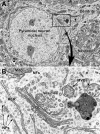

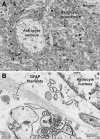


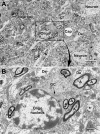
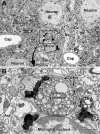
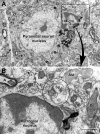

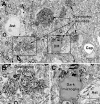

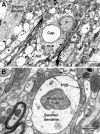
Similar articles
-
Ultrastructural pathology of glial brain tumors revisited: a review.Ultrastruct Pathol. 1997 Jan-Feb;21(1):1-31. doi: 10.3109/01913129709023244. Ultrastruct Pathol. 1997. PMID: 9029763 Review.
-
Cytoskeletal organization of the vestibular supporting cells. Saponin perfusion method for observing intracellular structures by scanning electron microscopy.Acta Otolaryngol. 1994 Mar;114(2):150-5. doi: 10.3109/00016489409126034. Acta Otolaryngol. 1994. PMID: 8203196
-
Ultrastructure of the central nervous system: the basics.Folia Neuropathol. 2004;42 Suppl B:1-9. Folia Neuropathol. 2004. PMID: 16903138 Review.
-
Dynamics of ultrastructural alterations in photosensitized crayfish glial and neuronal cells: Structures involved in transport processes and neuroglial interactions.J Neurosci Res. 2011 Mar;89(3):341-51. doi: 10.1002/jnr.22560. Epub 2010 Dec 22. J Neurosci Res. 2011. PMID: 21259321
-
Microfilaments in cellular and developmental processes.Science. 1971 Jan 15;171(3967):135-43. doi: 10.1126/science.171.3967.135. Science. 1971. PMID: 5538822
Cited by
-
Bone marrow-derived myeloid cells transiently colonize the brain during postnatal development and interact with glutamatergic synapses.iScience. 2024 May 21;27(7):110037. doi: 10.1016/j.isci.2024.110037. eCollection 2024 Jul 19. iScience. 2024. PMID: 39021809 Free PMC article.
-
Single-cell transcriptomics of the ventral posterolateral nucleus-enriched thalamic regions from HSV-1-infected mice reveal a novel microglia/microglia-like transcriptional response.J Neuroinflammation. 2022 Apr 6;19(1):81. doi: 10.1186/s12974-022-02437-7. J Neuroinflammation. 2022. PMID: 35387656 Free PMC article.
-
Effective extraction of polyribosomes exposes gene expression strategies in primary astrocytes.Nucleic Acids Res. 2023 Apr 24;51(7):3375-3390. doi: 10.1093/nar/gkad131. Nucleic Acids Res. 2023. PMID: 36881761 Free PMC article.
-
Evaluating ultrastructural preservation quality in banked brain tissue.bioRxiv [Preprint]. 2025 May 14:2025.05.09.652503. doi: 10.1101/2025.05.09.652503. bioRxiv. 2025. Update in: Free Neuropathol. 2025 Jun 25;6:13. doi: 10.17879/freeneuropathology-2025-6763. PMID: 40463251 Free PMC article. Updated. Preprint.
-
Evaluating ultrastructural preservation quality in banked brain tissue.Free Neuropathol. 2025 Jun 25;6:13. doi: 10.17879/freeneuropathology-2025-6763. eCollection 2025. Free Neuropathol. 2025. PMID: 40567433 Free PMC article.
References
Publication types
LinkOut - more resources
Full Text Sources
Other Literature Sources

